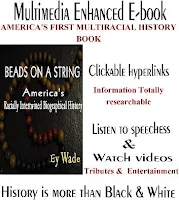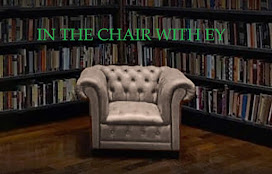The following words are the bare facts of America's History, all Beads included. A fantastic vehicle to honoring America and her veterans.
 Hiawatha fought for freedom of his people, Lonnie Johnson invented, Dalip Singh Saund governed, Rev. Rick Warren blessed, Arpad G. C Gerster educated, Antonio Meucci discovered, Will.i.am entertained, Minoru Yamasaki designed, and Amadeo Peter Giannini owned a business.
Hiawatha fought for freedom of his people, Lonnie Johnson invented, Dalip Singh Saund governed, Rev. Rick Warren blessed, Arpad G. C Gerster educated, Antonio Meucci discovered, Will.i.am entertained, Minoru Yamasaki designed, and Amadeo Peter Giannini owned a business.From the naming of the country by Martin Waldseemuller to the elimination of racial discrimination to the glorious day of racial, political and social unification, Beads on a String is America’s first interracial history book. It is written as an interactive, multimedia page turning ebook. All the reader has to do is click on the bolded words and they will be taken to the web link from which the short passage of biography or video was taken.
Beads on a String-America's Racially Intertwined Biographical History
This is a desktop version with page turning effects and videos embedded. Download it & love it.
SYNOPSIS
THE INTRODUCTION to the novel BEADS ON A STRING-AMERICA’S RACIALLY INTERTWINED BIOGRAPHICAL HISTORY consists of 8 pages and is dedicated to explaining the reason and need for America’s first and only interracial history book and begins with a quote on the first page from the author Ey Wade titled Beads on a String.“I feel that we as Americans are all equal and held together by a common thread. Like a treasured beaded necklace of different colors held together on a string, we are held together by our necessities and our circumstances and our humanity. Every color helps to make the necklace beautiful. We can never be a totally separate entity! Americans of all colors are so integrated that if we hurt one, we hurt all. Just like that necklace of treasured beads, leave one out and the gap is seen. Break the chain and many of us are lost.”
The section continues with A. Philip Randolph’s quote from Salvation for a Race “Salvation for a race, nation or class must come from within. Freedom is never given; it is won” before showing the purpose for the history book. The author states the fact she as a homeschooling parent and her youngest daughter were discussing the overuse of the hyphenation and the inability to find contributions of all races to America’s history in one book and how they decided to make their own. The author also goes on to say….“What is a better way, or so it seemed to us to celebrate America and it's freedoms than with a system established by the people with or without its faults and illusions? We chose to use Wikipedia as our resource because it was established by the people. People with interest in America's history, proud of their own heritage and who believed enough in themselves to gather and write about the people, organizations, and all fractions of society that helped to make America the great nation it has become. We believe in America and whenever We had doubt about the information we did go and check the information out at other sources and found Wikipedia to be pretty much correct on more information than not and the biggest factor was that it was so easy to use. Our main focus is to try and eliminate the division of a great nation by a single line, the hyphenation. Why do we keep the line of separation as a constant reminder of our racial differences? That hyphenation continues to put a space between the races that are naturally born and the races that have chosen to become Americans. Americans should drop the hyphen and pull together and teach our children that every bead has a purpose and should be celebrated. Beads on a String-America’s Racially Intertwined Biographical History has chosen not to be about a certain color, but about a certain Nation.”
The section ends with a page break and quote from Carlos Bulosan’s “America is in the Heart”“We in America understand the many imperfections of democracy and the malignant disease corroding its very heart. We must be united in the effort to make an America in which our people can find happiness. It is a great wrong that anyone in America, whether he be brown or white, should be illiterate or hungry or miserable.”
CHAPTER 1 is titled AMERICA. It begins on pages 9-12 with a quote from John Henrik Clarke’s All History is a Current Event.
“The events which transpired five thousand years ago; Five years ago or five minutes ago, have determined what will happen five minutes from now; five years from now or five thousand years from now."
Within this chapter the myth of Columbus discovering America and the timeline of immigration in the U.S. is explored. The first thing you see in this segment is a picture of the Statute of Liberty and a quote by Emma Lazarus from the New Colossus which begins with the words "Give me your tired, your poor….” In our quest to learn about America's colorful history and to ascertain the inclusion of the contributions from every race that has made America the great nation it is, our biggest wonder was how this great country received its name. Why the great America wasn't called 'Columbus'? In 1507 the map maker Martin Waldseemuller named North and South America, after Amerigo Vespucci. This chapter also gives a short biography on Vespucci.The phrase "united States of America" was first used officially in the Declaration of Independence, adopted on July 4, 1776. On November 15, 1777, the Second Continental Congress adopted the Articles of Confederation, the first of which stated "The Stile of this Confederacy shall be 'The United States of America.'" The name was originally proposed by Thomas Paine. For a while the Americas were also known as Columbia, after Columbus, prompting the name District of Columbia for the land set aside as the U.S. capital. Columbia remained a popular name for the United States until the early 20th century. America was so named after Amerigo Vespucci born March 9, 1451 in Florence, Italy. He was an Italian merchant, explorer and cartographer. Mundus Novus ("New World") was a Latin translation of a lost Italian letter sent from Lisbon to Lorenzo di Pierfrancesco de' Medici. It describes a voyage to South America in 1501-1502. It was a letter in Italian addressed to Piero Soderini. Printed in 1504 or 1505, it claimed to be an account of four voyages to the Americas made by Vespucci between 1497 and 1504. It was the publication and widespread circulation of the letters by Amerigo Vespucci that led Martin Waldseemüller to name the new continent America on his world map of 1507 in Lorraine. Along with placing the name on the map Waldseemüller also published Vespucci's accounts of his travels in a book. Vespucci used a Latinized form of his name, Americus Vespucius, in his Latin writings, which Waldseemüller used as a base for the new name, taking the feminine form America. The United States of America (also known as the United States, the U.S., the U.S.A., the U.S. of A., the States and America) is a country in North America that extends from the Atlantic Ocean to the Pacific Ocean and shares land borders with Canada and Mexico and a sea border with Russia and The Bahamas. The United States is a federal republic, with its capital in Washington, D.C. The United States of America consists of 50 states and one federal district; it also has numerous overseas territories.
At first, the country was open to anyone wishing to make a new start. Many came to America to escape war, poverty, famine, or religious persecution. Some came seeking fortune and others were brought against their will to work as slaves. These and other factors resulted in a large-scale influx of immigrants to the United States from around the world. Before 1882 anyone wishing to start a new life was allowed to settle in the United States, but with the huge growth of the population the federal government decided a monitoring system was needed.
In 1891, as part of the U.S. Treasury Department, the Office of Immigration was created and given authority over naturalization and moved to the U.S. Justice Department. (Today it is known as the Immigration and Naturalization Service.) In the same year, paupers, polygamists, the insane, and persons with contagious diseases were not allowed to enter the United States. 1892 Ellis Island opened. Between 1892 and 1953, more than 12 million immigrants were processed at this one facility. Early immigration laws aimed to preserve the racial, religious, and ethnic composition of the United States, which was then largely European. The first immigration laws were aimed at nonwhites. This chapter ends by showing examples of bindings put on entering immigrants and a page break and words written by John Hope Franklin "My challenge was to weave into the fabric of American history enough of the presence of blacks so that the story of the United States could be told adequately and fairly."
I Pledge Allegiance to the flag of the United States of America and to the republic for which it stands. One nation under God, Indivisible, with liberty and justice for ALL.
CHAPTER TWO- Titled Slavery and Discrimination in America is subtitled LABEL MY "RACE" HUMAN. The page begins with the stanza of The Pledge of Allegiance placed above the title of the chapter. This chapter discusses slavery, the use by states of Black Codes, and discrimination of all races that were not "free, white and twenty-one". It ends the words from Charles Evan Hughes Chief Justice U.S. Supreme Court, 1930-1941.It is amazing how the mere words of another person can effect and change the course of history, and the wealth, health and well being of another. Mere words, whether based on truth, personal beliefs or delusions can make or break a world, a nation, a life. Mere words. The different physical traits of African-Americans and Indians became markers or symbols of their status differences. The concept of race was developed and established by a study and thesis paper that was written by Johann Friedrich Blumenbach. Blumenbach who was born May 11, 1752 was a German physiologist and anthropologist. His thesis paper written about the difference in people and titled On the Natural Varieties of Mankind was considered on of the most influential papers of his time and basically established the way different races are seen in the world today. The separation of the people by race was established in order to institute the separation by social and economic differences. The idea of the Caucasian race to be superior to other races has been spread across the entire world. How people have been accepted and treated within the context of a given society or culture has a direct impact on how they perform in that society. Racial beliefs constitute myths about the diversity in the human species and about the abilities and behavior of people placed into "racial" categories. The myths combined the perception of behavior and physical features together in the public mind, and blocked the ability to understand behavior is not a genetic determination of a person. Temperaments, dispositions, and personalities, regardless of genetic, are developed by the life we live.
The idea of race in America was used as a way for the proponents of slavery to continue using humans as free labor, to keep the poor poor and make the rich richer while integrating the idea in the mind of the Caucasian that their 'race' was superior to that of the Indians and the African. Only society makes a difference between people. There is nothing in the law of nature that makes one color of person superior to another despite the fact that cultural differences, language barrier, and the color of skin all fused together to form a case that was set against another group of people. Years later Blumenbach wanted to change is opinions after falling in love with a woman of color.
The history of slavery in the United States began soon after Europeans first settled in the area (and so even before the founding of the United States), and officially ended with the ratification of the Thirteenth Amendment in 1865. Laws that came to be known collectively as the Black codes, ended officially in 2000. "What replaced the Black Codes, Leon F. Litwack wrote, "was not racial integration but an informal code of exclusion and discrimination."
No matter how great the nation of America is, it is a known fact it would not be the metropolis it is now without the use of chattel slaves or other kinds of unfree laborers, such as indentured servants. This used and often mistreated part of society whether descendants from native Americans, Africans, Chinese or Japanese and through strength and determination contributed enormously to our economic, scientific and physical growth.
"You may think that the Constitution is your security-it is nothing but a piece of paper. You may think that the statutes are your security-they are nothing but words in a book. You may think that elaborate mechanism of government is your security-it is nothing at all, unless you have sound and uncorrupted public opinion to give life to your Constitution, to give vitality to your statutes, to make efficient your government machinery." Charles Evan Hughes Chief Justice U.S. Supreme Court, 1930-1941
VOICES OF CHANGE
There are, it may be, so many kinds of voices in the world, and none of them are without signification.1 Corinthians 14:10
CHAPTER THREE brings forth some of the organizations that were established to fight for the rights that were guaranteed to America’s citizens.Civil Rights
In the United States, Civil Rights are the rights that a nation's inhabitants enjoy by law. The term is broader than "political rights," which refer only to rights devolving from the franchise and are held usually only by a citizen, and unlike "natural rights," civil rights have a legal as well as a philosophical basis. In the United States civil rights are usually thought of in terms of the specific rights guaranteed in the Constitution: freedom of religion, of speech, and of the press, and the rights to due process of law and to equal protection under the law.The civil-rights movement, led especially by Martin Luther King, Jr., in the late 1950s and 60s, and the executive leadership provided by President Lyndon B. Johnson, encouraged the passage of the most comprehensive civil-rights legislation to date, the Civil Rights Act of 1964; it prohibited discrimination for reason of color, race, religion, or national origin in places of public accommodation covered by interstate commerce, i.e., restaurants, hotels, motels, and theaters.
Besides dealing with the desegregation of public schools, the act, in Title VII, forbade discrimination in employment. Title VII also prohibited discrimination on the basis of sex. In 1965 the Voting Rights Act was passed, which placed federal observers at polls to ensure equal voting rights. The Civil Rights Act of 1968 dealt with housing and real estate discrimination. In addition to congressional action on civil rights, there was action by other branches of the government. The most notable of these were the Supreme Court decisions in 1954 and 1955 declaring racial segregation in public schools unconstitutional and the court's rulings in 1955 banning segregation in publicly financed parks, playgrounds, and golf courses. In the 1960s women began to organize around the issue of their civil rights.
Organizations--
Chinese American Citizens Alliance (CACA) is a Chinese American political organization founded in 1895 in San Francisco, California to secure equal rights for Americans of Chinese ancestry.The Student Nonviolent Coordinating Committee (SNCC, pronounced "snick") was one of the principal organizations of the American Civil Rights Movement in the 1960s. It was founded to help organize the student sit-ins, to fight segregation in restaurants and other public areas.
Greensboro Four civil rights activists. On Feb. 1, 1960 four black freshmen at North Carolina A&T State University, Franklin McCain, Joseph McNeil, Ezell Blair, Jr., and David Richmond, took seats at the segregated lunch counter of F. W. Woolworth's in Greensboro, N.C. The four have become icons of the civil rights movement.
Black Panthers, U.S. African-American militant party, founded (1966) in Oakland, Calif., by Huey P. Newton and Bobby Seale. Originally espousing violent revolution as the only means of achieving black
American Indian Movement (AIM) spearheaded in 1969 was co-founded by Anishinaabe Dennis Banks established to protect the traditional ways of Indian people and to engage in legal cases protecting treaty rights of The American Indian
CHAPTER FOUR- titled Biographies-Notable Contributors to America's Growth highlights in biographical form the ‘beads’ that form our nation. Each individual that helped America become a great nation, no matter the race, creed, political or professional stance is acknowledge within this chapter. It is written in single spaced form arranged by the century, areas of their focus and date of birth of each contributor. The chapter covers individuals from
Activism and Abolitionism
Government Leaders
Religious Leaders
Scholars and Educators
Inventors/ Science
Artists, Architects, Designers.
Authors and Publishers
Business
Sports to
Film, Television, Entertainment, and the Media.
Each segment begins with a quote from someone in the particular field of study. The chapter ends with a more extensive list which includes those who were not lauded with a short biography. The book ends with a bibliography containing the links to the web page in which to find the individual and with examples of the Black Codes that were used against ex-slaves in America. In the eBook a click of the mouse on the bolded name anywhere within the book will take you directly to the web page. The traditional eBook also contains videos such as:
A Change Has Come
Martin Luther King
Yes We Can
Lift Every Voice
We Shall Over Come
Why We Are Proud
We Are the Ones
The Dreams of Generations
The Inventor of the Supersoaker
Rev. Rick Warren
From Martin to Obama
It's a New Day
If you are interested in reviewing this book go here:
http://bit.ly/ReviewThis
- Reviews and Trailers
- First interview with the author Ey Wade
- Second Interview with the author
- What I Want for Jett
- Videos from inside the book
- Beads on a String-America's Racially Intertwined Biographical History
Kindle, Smashwords , Sony or Kobo, Scribed
Nook and iPad here & here.
What do you believe? Download the preview
Link Directly To This Post :
Link To The Homepage :















































